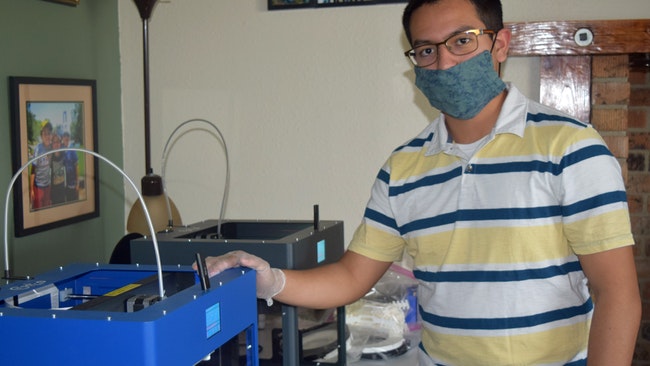 Jorge Mendieta, a junior at Vale High School, is one of four students who is using a 3D printer to print personal protective equipment for the region’s healthcare worker. (The Enterprise/Yadira Lopez)
Jorge Mendieta, a junior at Vale High School, is one of four students who is using a 3D printer to print personal protective equipment for the region’s healthcare worker. (The Enterprise/Yadira Lopez)
NOTE: The Enterprise is providing free access to its content related to the coronavirus as a community service. Subscriptions at $5 a month help the Enterprise keep this up.
VALE – Jorge Mendieta starts running the two 3D printers in his living room at about 8 a.m. and leaves them humming until around 11 at night.
The junior at Vale High School is one of four Malheur County students who are printing three-dimensional ear guards and headbands for face shields to provide personal protective equipment for the region’s healthcare workers.
“Because there’s such a shortage of PPE there’s been a big call for makers,” said Nickie Shira, the Malheur Education Service District STEM and innovation coordinator. “It’s this whole movement.”
The items the students have printed have been distributed to Saint Alphonsus Medical Center in Ontario and Fruitland, Valley Family Health Care and St. Luke’s Hospital.
Shira is among educators around the U.S. involving students in the effort to ramp up production of the much-needed protective gear. The shortage of PPE nationwide has been widely reported. A recent survey of more than 1,000 nurses conducted by the Service Employees International Union noted that more than 80% of those surveyed said they still don’t have enough protective gear.
Supply chains are starting to relax a bit now, but it’s been a challenge, said Elton Crawford, supply manager at Valley Family Health Care.
“The last month was horrendous. I’d have to spend six hours a day just trying to find stuff on the computer,” Crawford said. “We’re starting to build up some supplies now and we’ll be able to put some aside for a possible surge.”
All of the Valley Family clinics in Malheur County have received some of the materials made by the students.
Three-dimensional printing was introduced into the curriculum this school year, Shira said. There are 11 3D printers scattered throughout county schools. Shira reached out to four chief science officers – students elected by their peers to promote the sciences – from Ontario, Vale and Adrian high schools for the project. The Frontier STEM Hub is covering the cost of the filament to run the 3D printers.
 Allie Arizmendi, a senior at Ontario High School, points to the spool of filament at the back of a 3D printer she is running in her room. (The Enterprise/Yadira Lopez)
Allie Arizmendi, a senior at Ontario High School, points to the spool of filament at the back of a 3D printer she is running in her room. (The Enterprise/Yadira Lopez)
The students took printers home and have produced about 250 ear guards so far.
The ear guards are small pieces of plastic that are worn at the back of the head and attach to face masks. The material helps prevent the elastic ties on masks from digging into the ears and also helps tighten masks for a better fit.
Students have also printed more than 60 headbands for face shields. The bands have prongs to attach plastics visors.
“I saw other projects in the news of people doing this and I wanted to help,” said Allie Arizmendi, a senior at Ontario High School who is printing materials at home. “Since we’re out of school and I don’t have much to do.”
So Arizmendi was eager to join the project. She runs the two printers on a table and dresser in her bedroom until about 8 p.m. each day.
She said she’s used 3D printers at school before to make key chains and figurines. But this is her biggest project yet. On a recent weekday Arizmendi checked on the ear guards – the machines can print about seven at a time.
Headbands are trickier, Arizmendi explained as she pointed to the spool of nontoxic and biodegradable polylactic acid that feeds into the machine and gets heated. It takes about three hours to print a single headband.
“It’s a perfect project for our students to apply their skills to the real world and make a difference,” said Shira.
She said she stresses to students that STEM – which stands for science, technology, engineering and math – is about more than just studying certain subjects or using technology. The focus is on using those skills.
“This is a perfect example of that,” Shira said. “They have skills, know how to use the printers, they understand the tech and there’s a need.”
 Jorge Mendieta holds up one of the ear guards he printed on a 3D printer at home. (The Enterprise/Yadira Lopez)
Jorge Mendieta holds up one of the ear guards he printed on a 3D printer at home. (The Enterprise/Yadira Lopez)
Around the county, some locals have taken to old-fashioned sewing machines to produce face coverings.
Sarah Poe, director of the Malheur County Health Department, said these local efforts are helpful since surgical masks should be reserved for healthcare workers.
“We don’t want the public using surgical masks because that PPE really needs to go to health care personnel and first responders,” Poe said.
Handmade cotton face coverings, said Poe, are recommended for the public. The Health Department is working with two local groups to produce around 500 coverings for the department to distribute. Wearing them will need to become the norm as the state begins to relax restrictions, she said.
“We’re going to need to increase our precautions,” Poe said. “If you’re not isolated in your house that means you need to be more careful when leaving your house, so we need people to be wearing those cloth face coverings.”
In Vale, Pauline Sheehan said she can hardly keep up with demand. For weeks now she’s put out a basket in front of her home with free face coverings for the taking. Sheehan said people have started requesting orders.
She’s used 12 bobbins so far, making about 11 coverings for each one. Vale, Sheehan said, “needs more people to sew homemade cotton masks.”
Crawford said the clinics have received a lot of donated face coverings, too, as friends and family of staff members got to work sewing.
Producing these handmade materials may have an added benefit for people who are anxious or frustrated, Poe said.
For those people, finding a way to give back and be part of the effort to protect the community may be a balm.
“I really encourage people to make them and I really appreciate the ingenuity and creativity of people who have the ability to give back and have those skills,” Poe said.
Have a news tip? Reporter Yadira Lopez: [email protected] or 541-473-3377
HELP THE COMMUNITY GET THE FACTS….
As long as we can, the Malheur Enterprise will provide free access to all stories related to COVID-19. With businesses closed and not advertising, community support for this service is vital. Help one of two ways:
SUBSCRIBE – $5 a month, automatically.
DONATE – to our LOCAL NEWS FUND. Tax deductible, and anonymous if you wish.
Thank you!




